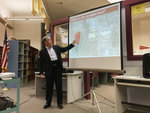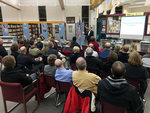

Plans are beginning to take shape for a proposed new elementary school on the south side of Chehalis that would effectively replace two aging facilities.
But before Chehalis school officials ask residents living in the district to foot the bill, a Tuesday meeting at the W.F. West High School library aimed to give them a glimpse of and opportunity to give feedback on the proposed undertaking.
Chehalis Superintendent Ed Rothlin gave a presentation to more than 30 people, showing them the details of what a possible $36 million bond would fund: a new elementary school that would sit on land near 20th Street and Salsbury Avenue, along with improvements to Olympic Elementary and Chehalis Middle School that would basically turn the area into a centralized campus bisected by 20th Street.
The project, which would cost $56 million in all with $20 million funded by matching money from the state, would replace Cascade Elementary and R.E. Bennett Elementary, two adjacent buildings serving lower elementary school-aged children just south of downtown Chehalis.
“When our bond issue in 2011 failed, I sat with a group of community folks. … They thought the location (of R.E. Bennett and Cascade) was a crummy location. It wasn’t a safe place and it just didn’t make sense,” Rothlin explained. “The question became, ‘What about that big field next to the middle school, across from Olympic?’”
The push for a new school was bolstered by the donation of a $1.9 million piece of property, gifted to the district from the family of Gail Shaw, a longtime community supporter and industry leader who died earlier this year. The district had already been in talks with Shaw on how they could acquire the property, but the gift means the district pays nothing for a key piece of land.
“It was important to Gail that this property be offered to the district,” Rothlin said. “We didn’t know how much this was going to cost us at first.”
Issues brought up in the bond proposal in 2011 remain, such as inefficient heating, cooling and electrical systems in the two schools that were built in the 1920s. The capacity for upgrades at both schools is limited at best, Rothlin said, and both schools would be poorly equipped to handle larger numbers of new students coming into the district.
Age is, however, the biggest factor, several officials said.
“We always say that when Cascade was built, the White House got its first radio,” board member Vicki Daniels said, eliciting a few chuckles from the crowd.
With the location of the proposed building set, the only thing the district must do is ask voters to pay for the construction. The Chehalis School District Board of Directors will soon need to pass a resolution asking to put the bond on the February ballot, and nearly all members of the audience — most of whom were employees of the district — raised their hands when Rothlin asked how many people present would show support for such a resolution.
A majority of voters supported a 2011 bond proposal to replace the two aging school buildings, but 52 percent wasn’t enough to clear the state-required supermajority hurdle of 60 percent plus one vote. The tax rate stood at $1.28 per $1,000 of assessed value then, and Rothlin said this time around it would be 17 cents lower, at $1.11.
“We’re debt free, interest rates are favorable and we could take advantage of those,” Rothlin said.
Several members of the public provided feedback during the forum. One parent proposed upgrades to athletic facilities across the district to be included in the bond, and another asked if a performing arts center of sorts could be added. Still another brought up an idea to build a connector road from the proposed campus to Interstate Avenue to alleviate traffic problems.
One member of the community said he believes the district had relied on the city of Chehalis’ strong voting record in supporting schools in the past, and the district and bond committee would need to send a strong message to voters of the urgency of the situation.
“It’s a different world than it has been. It’s a different town, and we need to educate people,” the man said. “I wanted it to pass, but here we are a few years later with an even better opportunity.”
Board president Colleen State closed out the hourlong meeting with vocal support for the proposed new school, saying the district is in good financial shape to attempt the undertaking.
“There will always be something that needs to be done, but this is the first step in the long-range plan,” State said. “We’re lucky to have not had bond payments for years, and this will be worth the tradeoff to create a new K-8 situation where we have the schools together in kind of a hub.”